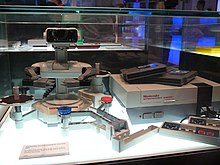R.O.B.
Following the North American video game crash of 1983, Nintendo alleviated that fearful retail market by rebranding its Japanese Famicom video game console as the Nintendo Entertainment System—a new platform focused on R.O.B.
to further reclassify the system as a uniquely sophisticated toy experience instead of simply as a video game console.
[4]: 213–214 With a high volume of low quality products and dead-inventory shovelware,[4]: 213 some retailers and industry critics considered video gaming to be a passing fad altogether.
[5] Therefore, Nintendo spent much of 1984 re-conceiving its Family Computer (Famicom) platform from Japan to be portrayed in America not as a traditional video game console, but as a new kind of sophisticated entertainment experience.
[6][4]: 213–214 [7] Nintendo saw the industry's overwhelming trend away from game consoles and toward home computers, but its prototype of a lavish Famicom-based home computer and multimedia package called Advanced Video System (AVS) was poorly received at the January 1985 Winter Consumer Electronics Show, so that was redesigned into a cost-reduced toy motif.
[7] The Famicom's whimsical appearance was again rebranded with a serious naming and industrial design language similar to the AVS, called the Nintendo Entertainment System (NES).
The NES is based on the Control Deck game console, which is shaped like high-tech videophile equipment with a front-loaded and door-enclosed cartridge port in the style of the modern VCR instead of a typically top-loaded "video game console".
Nintendo marketing executive Gail Tilden recalled, "That thing was definitely like watching grass grow.
It was so slow, and to try and stand there and sales-pitch it in person and try to make it exciting; you had to have the eyes lined up just right or it wouldn't receive the flashes.
[11][12] Nintendo's brochure for attracting distributors shows a prototypical hybrid between AVS and NES with R.O.B., saying, "The future of home entertainment is staring you in the face.
[6][12] The robotic persona reportedly "worked like a charm" to drive intrigued visitors to Nintendo's booth, but nobody signed up to be a distributor of the upcoming NES.
[6] The toy robot is the highlighted accessory within the first and most premium NES consumer product offering, the Deluxe Set boxed bundle of Control Deck, R.O.B., Zapper light gun, Gyromite, and Duck Hunt.
This bypassed the crashed video game stigma and launched it more safely from the toy sections of retail stores[7] next to established hit robot toys like Transformers, Voltron, Go-Bots, Teddy Ruxpin, and Lazer Tag.
[6][5] Soon in 1985 came the second and final entry in the Robot Series, Stack-Up, packaged separately along with its own physical game pieces.
product was filed by Gunpei Yokoi as "photosensing video game control system",[8] with the same optical electronics as a Zapper,[4]: 213 and likewise only functions correctly with a cathode-ray tube (CRT) television and not an LCD.
Only two officially licensed games were published for R.O.B., which comprise Nintendo's Robot Series: Gyromite and Stack-Up.
Computer Entertainer reported Nintendo's supposed plans as stated prior to CES June 1985, for four more nondescript Robot Series games, but they were never released.
Gyromite is a puzzle platform video game in which main character Professor Hector must collect dynamite before the time runs out, with his path blocked by several red and blue pillars and by dinosaur-like creatures called Smicks.
[16] In Game A, the commands are made by pressing START and then pushing the direction in which to move R.O.B., and using the A and B buttons to open and close his arms.
[citation needed] Stack-Up comes with five trays, five different colored circular blocks, and two claws worn by R.O.B.
In the Direct game mode, the player makes the block stack match with the one shown on screen by moving Hector to the button that corresponds to the desired movement.
In Memory, the player makes a list of commands to recreate the displayed block setup, and then R.O.B.
In 2014, independent game developer Retrozone produced a limited release NES cartridge titled 8-Bit X-Mas 2014.
and Robot Series had received none of Nintendo's promised updates while the rest of the NES's library had exploded with classic flagship franchise-building hits like Super Mario Bros., The Legend of Zelda, and Metroid.
magazine visited a toy fair in England to observe a playthrough of Gyromite with R.O.B., saying of the struggling demonstrator that he had "never seen anything so complicated and difficult in all my life".
[19] In July 1987, Family Computing magazine advocated buying the much cheaper and more entertaining setup of the Control Deck and Super Mario Bros. instead of R.O.B., saying, "Anyone who has seen a Nintendo ad on television would think that R.O.B.
Once the novelty of controlling a robot's arms and spinning a glorified top had worn off, usually within days or even hours, R.O.B.
He required battery replacements too often, and it was immediately apparent that the maze barriers in Gyromite could be turned on and off just as easily by tapping the A and B buttons on a standard controller, which was all that R.O.B.
's discontinuation to have become immaterial because the product's whole existence has ultimately amounted to "merely a Trojan Horse to get NES systems into American homes".
This, in turn, secured the survival of Nintendo of America and revitalized the entire video game industry.


